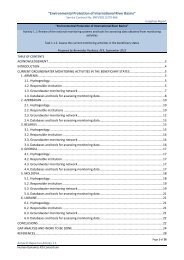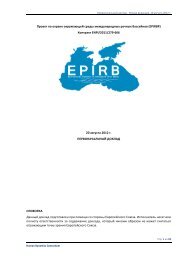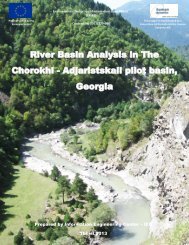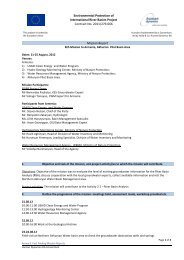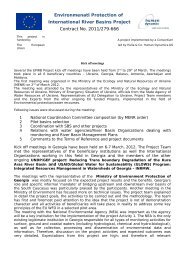Nokia Standard Document Template - Environmental Protection of ...
Nokia Standard Document Template - Environmental Protection of ...
Nokia Standard Document Template - Environmental Protection of ...
- No tags were found...
You also want an ePaper? Increase the reach of your titles
YUMPU automatically turns print PDFs into web optimized ePapers that Google loves.
4th Mission Report _KE3_Jan –Feb 2013The details <strong>of</strong> the course is shown in Appendix 6.RecommendationsFor the GLC analysis the following recommendations should be considered:i.) Obtain the EPA method 608/808 to assist in identifying the current chromatographic peaks.ii.) Produce a SOP to clarify the operational, calibration & quantification procedures.iii.) Research into the inclusion <strong>of</strong> an internal calibration standard within the samples.iv.) Replaced the current HDPP plastic bottles with 2l amber glass bottles with ground glass stoppers orcaps with Teflon inserts.v.) Keep a reserve nitrogen carrier gas cylinder in stock.vi.) Install carbon filters inline from the gas cylinder to the GLC to prevent gross contamination.vii.) Engage Vakhtang Ugrekhelidre, GLC expert (Georgian Isotopic Institute), to assist in the aboverecommendations.viii.) The project should obtain a calibration OCP standard to complete the training.For the quality control the water department should increase their number <strong>of</strong> parameters that apply AQCstandards to check their analysis ready for the JFS.For the hydrobiological analysis, further training and assistance for determining the BMI species level andEQR values, is required by the project plus for the project to a study/training tour at a European Centre <strong>of</strong>Excellence. To complete the training for the calculation <strong>of</strong> the BMI biotic indices the Aquabiobases<strong>of</strong>tware will be required by the Project.Batumi Laboratory – the Black Sea Monitoring Division, Environment Pollution Monitoring DepartmentNEA- 6th -9th FebruaryFollowing discussions with following management staff:Marina Arabidze, NEA Georgia Head <strong>of</strong> Environment Pollution Monitoring DepartmentIrine Baramidze, NEA , Head <strong>of</strong> Water Quality Laboratory,it was decided that two important analytical apparatus for the analysis <strong>of</strong> samples for the Project requiredurgent attention: The Perkin Elmer Atomic Absorption Spectrophotometer (AAS) 600 The Perkin Fluorescence Spectrophotometer (FS)451) Atomic Absorption SpectrophotometerThe AAS model (600) is advanced equipment, using a carbon furnace with the Zeeman facility, whichshould be able to analyse most <strong>of</strong> the heavy metals very accurately and to a very low LOD. Unfortunatelythe Perkin Elmer Agent in Georgia apparently had not been very helpful and had quoted very high pricesjust to diagnose the problems, let alone repair the instrument. Also the agent appeared to have maderecommendations, which were expensive and counterproductive, e.g. it was recommended that the clientneeded a UPS system. However, it really was not feasible to use such a system, as the instrument usesvery high currents <strong>of</strong> 32 amps and most UPS systems cannot normally operate at such high currents.The following issues were addressed:Page 13 <strong>of</strong> 36




